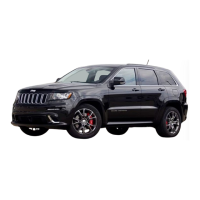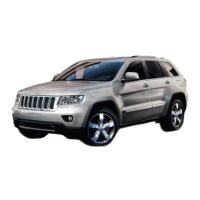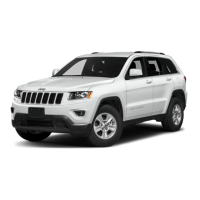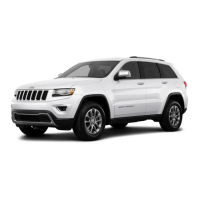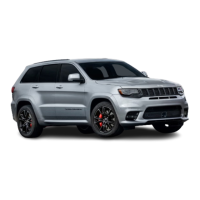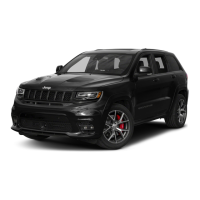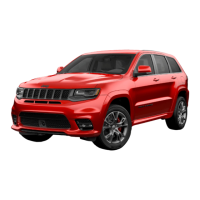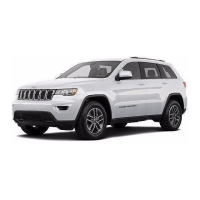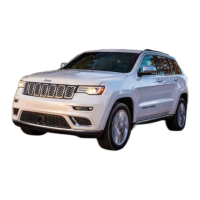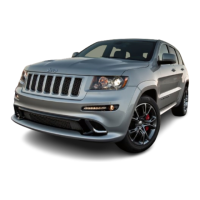
Do you have a question about the Jeep Grand Cherokee SRT8 2012 and is the answer not in the manual?
| Brand | Jeep |
|---|---|
| Model | Grand Cherokee SRT8 2012 |
| Category | Automobile |
| Language | English |
Information on the higher rollover rate of utility vehicles due to their ground clearance and center of gravity.
Guidance on navigating the manual using the Table of Contents and index for specific information.
Explanation of WARNINGS against procedures causing collision/injury and CAUTIONS against procedures causing damage.
Location and importance of the VIN for vehicle identification and optional equipment records.
Warning about modifications affecting roadworthiness and safety, potentially leading to serious injury or death.
Explanation of the keyless ignition system, Key Fob, and Wireless Ignition Node (WIN).
Details on the Sentry Key system preventing unauthorized vehicle operation by disabling the engine.
Information on how the security alarm monitors doors, liftgate, and ignition for unauthorized operation.
System description allowing locking/unlocking doors and liftgate, or activating panic alarm remotely.
Details on safety features like three-point belts, advanced front airbags, and supplemental side airbags.
Information on the proper use and function of lap/shoulder belts, including retractors.
Guidelines for properly seating and restraining children in the vehicle, including specific age and weight recommendations.
Recommendations for driving moderately during the first 500 miles for proper drivetrain break-in.
Adjusting outside mirrors for optimal view and information on automatic dimming features.
Details on the voice-activated, hands-free communication system and supported mobile phones.
Instructions on using voice commands to operate the Uconnect™ Phone and navigate menus.
System description using radar sensors to detect vehicles in blind spot zones and provide alerts.
Information on seats as part of the Occupant Restraint System, including power seat adjustments.
Operation of the headlight switch, automatic headlights, and fog lights.
System operation for controlling vehicle speed, including activation, setting speed, and deactivation.
System description for maintaining a set distance from the vehicle ahead using radar sensors.
System providing visual and audible indications of distance to obstacles when backing up.
Camera system providing an on-screen image of rear surroundings when the shift lever is in REVERSE.
Features of the overhead console including lights, storage, and universal garage door opener.
Programming and operation of the HomeLink system to control garage doors and other devices.
Operation of the power sunroof, including express and manual modes, and pinch protection features.
Operation of the command view sunroof and power shade, including express and manual modes.
Information on 12 Volt power outlets, their labeling, and usage precautions.
Details on the 115 Volt, 150 Watt inverter outlet and its overload protection features.
Location of cupholders for front and rear seat passengers.
Description of various storage compartments including glove compartment, door storage, and center console.
Features related to the cargo area, including a rechargeable flashlight and storage bins.
Identification and location of various instrument panel components and controls.
Diagram and numbering of the instrument cluster gauges and indicators.
Detailed explanations of various instrument cluster indicators and lights.
Pre-operation checks including seat adjustment, mirrors, seat belts, and passenger instructions.
Guidelines for operating the automatic transmission, including shift lever positions and precautions.
Explanation of the keyless ignition system with push-button start and Remote Keyless Entry.
Procedure for starting the engine using the ENGINE START/STOP button.
Recommendations for reliable starting in temperatures below –20°F (–29°C), including engine block heaters.
Troubleshooting steps for a flooded engine and warnings regarding push/tow starting and jumper cables.
Information on automatic idle speed control and how it decreases as the engine warms up.
System requiring shift lever in PARK before turning ignition to LOCK/OFF.
System holding shift lever in PARK unless brakes are applied.
Explanation of shift lever position display and movement requirements.
Information on gear ranges and warnings against racing the engine when shifting.
Driver-interactive transmission feature for manual gear shifting and improved vehicle control.
Description of Selec-Track™ system combining vehicle control systems for optimal terrain performance.
Precautions and warnings when driving through water, including depth limits and potential damage.
Description of the power steering system, its response, and behavior when power assist is lost.
Procedure for applying and releasing the foot-operated parking brake.
Overview of the advanced electronic brake control system including ABS, TCS, BAS, ERM, ESC, and TSC.
General information about tires, including pressure, safety, and economy factors.
Information on tire markings, safety grades, and proper inflation.
Recommendations for timely tire rotation to ensure even wear and optimal performance.
System that warns the driver of low tire pressure based on recommended cold tire pressure.
Safety tips and information on limits for towing trailers with the vehicle.
Definitions of terms related to trailer towing, including GVWR, GTW, and GCWR.
Essential tire inflation and inspection procedures before towing a trailer.
Information on trailer brake systems, including controller requirements and recommendations.
Tips for providing optimum towing performance and protecting transmission components.
Information stating that recreational towing is not allowed.
Operation of the hazard warning flasher switch for emergency signaling.
Steps to reduce overheating potential, including turning off A/C and using heat.
Information on run-flat tires and the process of jacking and changing a tire.
Procedures for safely jump-starting a vehicle with a discharged battery using jumper cables or a booster pack.
Location and usage of emergency tow hooks for off-road recovery.
Procedure to temporarily move the shift lever if it cannot be moved out of PARK due to malfunction.
Manufacturer's requirement to tow the vehicle with all four wheels off the ground using a flatbed.
Diagram and identification of major components in the 6.4L engine compartment.
Explanation of the OBD II system monitoring emissions, engine, and transmission control systems.
Legal requirements for passing emissions inspections for vehicle registration.
Recommendation to use genuine MOPAR parts for maintenance and repairs to ensure performance.
Information on the qualifications and expertise of authorized dealers for service operations.
Overview of required maintenance services determined by vehicle engineers.
Procedures for checking engine oil level, changing oil, and selecting engine oil.
Recommendation to replace the engine oil filter with a new one at every engine oil change.
Maintenance intervals for the engine air cleaner filter and its protective function against backfire.
Information on the maintenance-free battery, requiring no water addition or periodic maintenance.
Recommendations for checking and servicing the air conditioner at the start of each warm season.
Periodic lubrication of locks, pivot points, hinges, and latching components with lithium based grease.
Instructions for cleaning wiper blades and windshield, and avoiding damage from frost or petroleum products.
Procedure for refilling the windshield and rear window washer fluid reservoir with solvent.
Importance of a maintained exhaust system for preventing carbon monoxide entry and warnings.
Safety precautions when working near the radiator fan and hot coolant, and coolant level checks.


